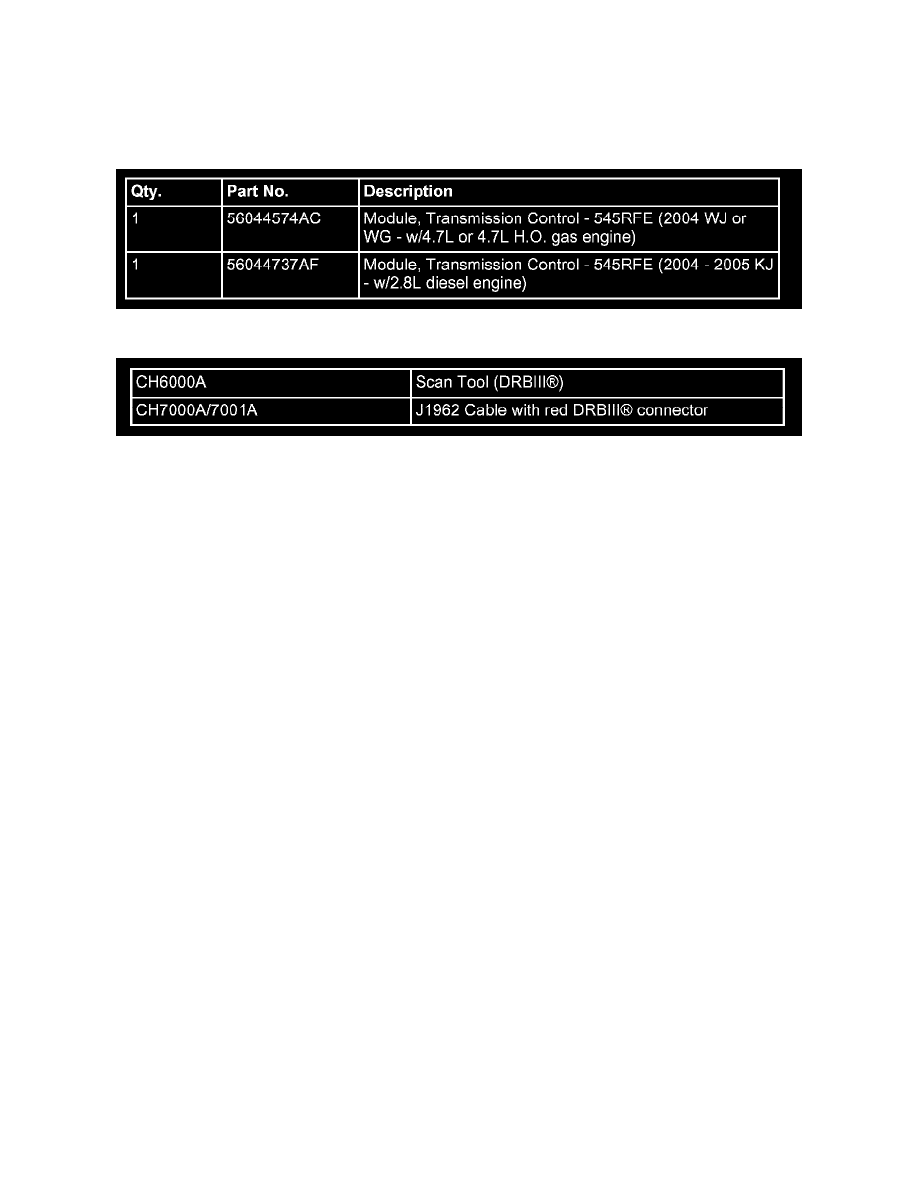Grand Cherokee 2WD V8-4.7L VIN J (2004)

3.
If the DTC is one of the above "Gear Ratio Error" faults listed above, then proceed to the next step. If not, then this bulletin does not apply and
further diagnosis is required.
4.
Using the DRB III(R) scan tool, check the "DTC Event Data". Is the "Line Pressure" reading displayed in the "DTC Event Data" within 103 Kpa
(15 psi) of the "Desired Line Pressure" reading? If yes, then this bulletin does not apply and further diagnosis is required. If the "Line Pressure"
reading is 103 Kpa (15 psi) or more below the "Desired Line Pressure", then perform the Repair Procedure.
PARTS REQUIRED:
SPECIAL TOOLS/EQUIPMENT REQUIRED:
NOTE:
An updated J1962 cable has been released. This cable has a red colored connector at the DRBIII(R) connection.
REPAIR PROCEDURE:
1.
Disconnect and isolate the negative battery cable from the battery.
2.
Replace the Transmission Control Module (TCM).
3.
Connect the negative battery cable to the battery, set the clock to the correct time, and clear any TCM DTC's which may be present.
4.
Using the DRBIII(R), compare the "Actual Line Pressure" reading to the "Desired Line Pressure" value (goal) with the vehicle in Park and the
engine running at 1,500 RPM.
5.
If the "Actual Line Pressure" reading is less than the "Desired Line Pressure" value by 103 Kpa (15 psi) or more, then further diagnosis and repair
of the transmission will be required. Refer to NOTE below.
6.
The transmission line pressure is considered good/normal if the "Actual Line Pressure" reading is within +/- 34 Kpa (+/- 5 psi) of the "Desired
Line Pressure" value. Momentary small fluctuates in "Actual Line Pressure" greater than +/- 34 Kpa (+/- 5 psi) may occur. If the "Actual Line
Pressure" reading is within +/- 34 Kpa (+/- 5 psi) of the "Desired Line Pressure" value, proceed to the next step.
7.
Using the DRBIII(R), perform a 1st Gear Clutch Test and a Reverse Gear Clutch Test. If either test fails (input speed does not remain at zero),
then further diagnosis and repair of the transmission will be required. Refer to NOTE below.
8.
If the 1st Gear Clutch Test and the Reverse Gear Clutch Test pass, then proceed to the next step.
NOTE:
If the "Actual Line Pressure" is below specification (less than 103 Kpa / 15 psi) of the "Desired Line Pressure, or if either the 1st Gear Clutch or the
Reverse Gear Clutch Tests fail, then repair to the transmission may be required. Remove the transmission, inspect the clutches and repair as
necessary. Often corrective action may only involve repair to a specific set of clutch discs and separator plates (clutch pack). Possible repair to the
transmission is not addressed by this Service Bulletin.
NOTE:
If the transmission requires disassembly for repair to mechanical components, verify that the pump gears are intact and that the main regulator valve
(located in the pump valve body) moves freely in its bore.
9.
Using the DRBIII(R), perform the transmission Quick Learn Procedure.
10.
Perform the transmission diagnostic Verification Procedure. Refer to TechCONNECT for detailed instructions, Diagnostic Tab, 7.0 Diagnostic
